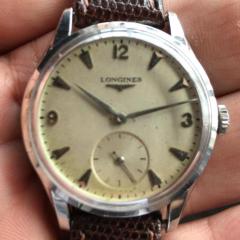Oiling advice
-
Recently Browsing
- No registered users viewing this page.
-
Topics
-
Posts
-
1. I think the pivots look pretty good and I wouldn't worry about wear. 2. Yes, I think the hole jewels should come out for cleaning, complete with their spring setting. I don't have experience with Rolex but I've seen this spring type setting in another movement. They may be stuck in with old dried oil. 3. Yes, I think the overcoil is out of shape.
-
By Michalzeszen · Posted
Yes, I'm looking at this option. I have a good friend from childhood who happens to be a goldsmith, and he would certainly be able to tackle the second hole to my specifications. I usually avoid this path because, since he deals with gold pieces, every time he stops to help me with "frugal" parts, he is objectively losing money. I agree with you. Even though I couldn't justify paying this much for the set (they only sell the whole set or the sole case tube), I understand the price tag. The trouble with this particular stem set is that the most common use case for it is the Technos Skydiver, a watch whose price certainly justifies 220 USD for a brand-new stem set. I have messaged them only on the surface, without specifying my needs. They already stated that they don't sell the single female part, only the full set. What I still don't get is the need for a second hole. Is it supposed to be some sort of regulation, meaning that I can fit the head of the male part in any of the two holes to adjust the pressure of the spring? Does this mean that a single-hole female part has a chance to work with my setup? I'll later test this hypothesis while continuing the assembly of the movement. Some photos are attached. Can you judge this bracelet? It was dirt cheap (4 USD), genuine leather, wife's choice. I have just realized my dial is upside down. lol -
By Juleswatch · Posted
Hello from chilly Brazil! I just bought a couple of watches and this watch came with them. While perhaps not worth much I'd like to try to find out something about it. Googling comes up with with the name Gerald Genta, and I see from internet searches he's made some nice designs (perhaps an understatement)! Also some cartoon designs but I can't find anything like this anywhere, so most likely not his! Googling Royama I see that some famous people liked his watches and also the Royama watches. Two questions; 1. Can anybody tell me anything about this watch and its background? 2. How to get the base off to let down the main spring which is fully wound. I gently tried prying it but nothing, I see there is a button but have no idea if it is functional for removing the back or anything else. Screwed back maybe? I really don't want to break the back or the watch with too much pressure and haven't looked up the properties of Grilamid! Probably not much of a watch but it peaked my curiosity and I hope somebody might be able to help? The auctioneer sold it as a psychedelic acrylic 1960/70 Royama watch overwound! All the best...Jules -
What do you use as pivot drills @nevenbekriev?
-










Recommended Posts